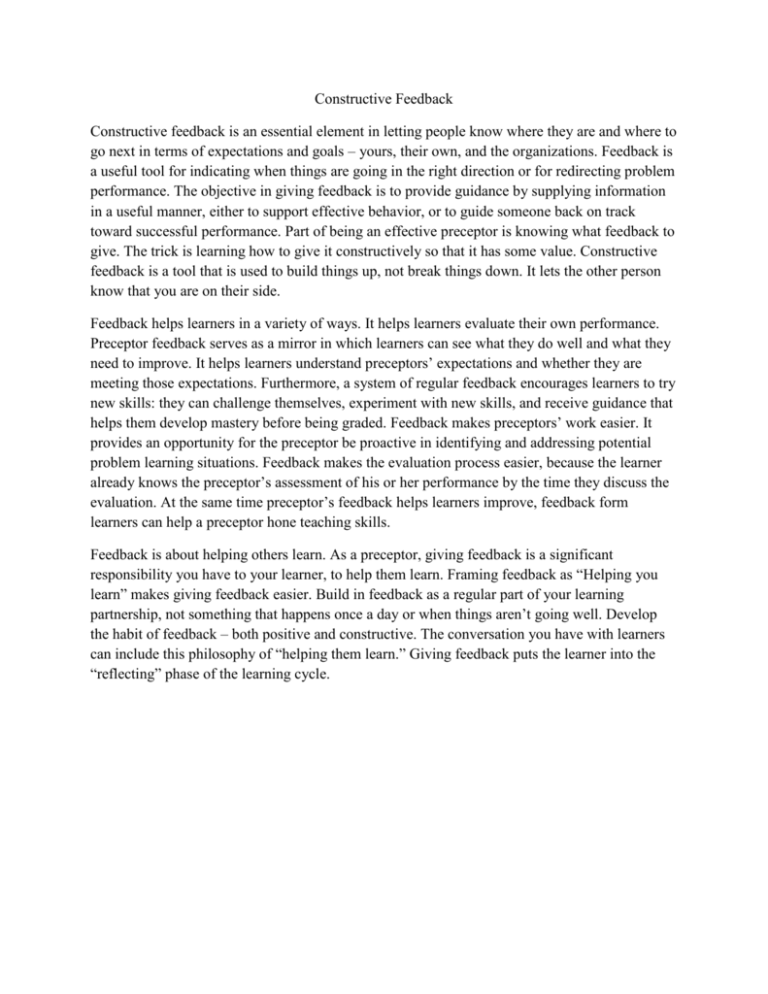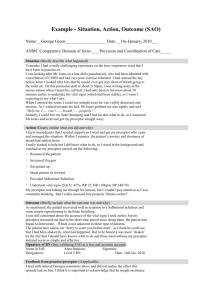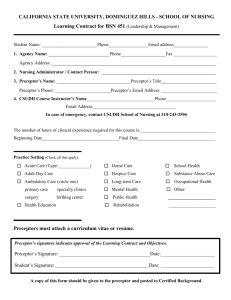Constructive Feedback
advertisement

Constructive Feedback Constructive feedback is an essential element in letting people know where they are and where to go next in terms of expectations and goals – yours, their own, and the organizations. Feedback is a useful tool for indicating when things are going in the right direction or for redirecting problem performance. The objective in giving feedback is to provide guidance by supplying information in a useful manner, either to support effective behavior, or to guide someone back on track toward successful performance. Part of being an effective preceptor is knowing what feedback to give. The trick is learning how to give it constructively so that it has some value. Constructive feedback is a tool that is used to build things up, not break things down. It lets the other person know that you are on their side. Feedback helps learners in a variety of ways. It helps learners evaluate their own performance. Preceptor feedback serves as a mirror in which learners can see what they do well and what they need to improve. It helps learners understand preceptors’ expectations and whether they are meeting those expectations. Furthermore, a system of regular feedback encourages learners to try new skills: they can challenge themselves, experiment with new skills, and receive guidance that helps them develop mastery before being graded. Feedback makes preceptors’ work easier. It provides an opportunity for the preceptor be proactive in identifying and addressing potential problem learning situations. Feedback makes the evaluation process easier, because the learner already knows the preceptor’s assessment of his or her performance by the time they discuss the evaluation. At the same time preceptor’s feedback helps learners improve, feedback form learners can help a preceptor hone teaching skills. Feedback is about helping others learn. As a preceptor, giving feedback is a significant responsibility you have to your learner, to help them learn. Framing feedback as “Helping you learn” makes giving feedback easier. Build in feedback as a regular part of your learning partnership, not something that happens once a day or when things aren’t going well. Develop the habit of feedback – both positive and constructive. The conversation you have with learners can include this philosophy of “helping them learn.” Giving feedback puts the learner into the “reflecting” phase of the learning cycle. Constructive Feedback Identify the educational purpose Find someplace private Focus on an observed behavior Speak in the first person Encourage self-assessment Utilize the positive-negative-positive approach Be specific and timely Keep it simple and slow Negotiate an action plan Plan for follow-up feedback Aim to provide feedback on a routine basis. The more often you provide feedback, the easier it becomes. (Maurer, 1994). Six Ways to Give Constructive Feedback 1. State the constructive purpose of your feedback. State the purpose briefly by indicating what you’d like to cover and why it’s important. If you are initiating feedback, this focus keeps the other person from having to guess what you want to talk about. If the other person has requested feedback, a focusing statement will make sure that you direct your feedback toward what the person needs. For example: “I have a concern about…” “I feel I need to let you know…” “I want to discuss…” “I have some thoughts about…” 2. Describe specifically what you have observed. Focus on description rather than judgment. Describing behavior is a way of reporting what has occurred, while judging behavior is an evaluation of what has occurred in terms of “right or wrong,” or “good or bad.” By avoiding evaluative language, you reduce the need for the individual to respond defensively. For example: “You demonstrate a high degree of confidence when you answer medication questions with the patient,” rather than, “Your communication skills are good.” Have a certain event in mind and be able to say when and where it happened, who was involved, and what the results were. Stick to what you personally observed and don’t try to speak for others. Avoid talking vaguely about what the person “always” or “usually” does. 3. Focus on observation rather than inference. Describe your reactions. Observations refer to what you can see or hear about an individual’s behavior, while inferences refer to the assumptions and interpretations you make from what you see or hear. Focus on what the person did and your reaction. For example: “When you gave the patient her prescription, you tossed it across the desk,” rather than describe what you assume to be the person’s motivation, “I suppose you give all prescriptions out that way!” Explain the consequences of the other person’s behavior and how you feel about it. Give examples of how you and others are affected. When you describe your reactions or the consequences of the observed behaviors, the other person can better appreciate the impact their actions are having on others and on the organization or team as a whole. For example: “The patient looked embarrassed and I felt uncomfortable about seeing the episode.” 4. Give the other person an opportunity to respond. Focus on behavior rather than the person. Refer to what an individual does rather than on what you imagine she or he is. To focus on behavior, use adverbs, which describe action, rather than adjectives, which describe qualities. For example: “You talked considerably during the patient’s appointment, which prevented me from getting to some of the main points,” rather than “You talk too much.” Remain silent and meet the other persons’ eye. Indicating that you are waiting for an answer. If the person hesitates to respond, ask an open ended question. For example: “What do you think?’ “What is your view of this situation?” “What is your reaction to this?” “Tell me, what are your thoughts?” 5. Provide a balance of positive and negative feedback. Offer specific suggestions. If you constantly give only positive or negative feedback, people will distrust the feedback, and it will become useless. Whenever possible make your suggestions helpful by including practical, feasible examples. Offering suggestions shows that you have thought past your evaluations and moved to how to improve the situation. Even if people are working up to expected standards, they often benefit from ideas that could help them perform better. If your feedback is offered supportively or neutrally, in the “for your information” mode, or depending on the situation’s circumstances, suggestions may not be appropriate. Use your common sense and offer an idea if you think the other person will find it useful. Don’t drum up suggestions for improvement just for the sake of it. 6. Summarize and express your support. Be aware of feedback overload. Select two or three important points you want to make and offer feedback about these points. Review the major points you discussed. Summarize the action items, not the negative points of the other person’s behavior. For corrective feedback, stress the main things you’ve discussed that the person could do differently. End on a positive note be communicating confidence in the person’s ability to improve the situation. By summarizing you can avoid misunderstandings and check to make sure that your communication is clear. This summary is an opportunity to show your support for the other person—a way to conclude even a negative feedback situation on a positive note. (Adopted from Concordia University Nurse Practitioner Preceptor Handbook & Profiles International, How to Give Constructive Feedback in 6 Easy Steps) Why is giving and receiving feedback so important? Some of the most important data we can receive from, or give to others, consists of feedback related to behavior. Such feedback can provide learning opportunities for each of us if we can use the reactions of others as a mirror for observing the consequences of our behavior. What follows is a brief outline of some of the factors that may assist you in checking and developing your use of feedback as a giver, receiver and model. 1. Refer to what a person does, rather than what we think he or she is. Example: “You were very quiet tonight Linda.” Not: “You are not interested in our discussion, are you?” 2. Refer to what you see or hear, not why you thought it happened. Example: “You suddenly went quiet when we talked about life planning.” Not: “You are probably afraid to think ten years ahead.” 3. Describe the behavior you are responding to in terms of “more or less” rather than “either/or.” Example: Describe someone’s participation or performance on a continuum of high to low, rather than “good” or “bad.” 4. Feedback is most useful if given as soon as possible after the observation or reaction. This way the other person can relate it to the facts and emotions of the situation and make better use of the feedback. 5. Give feedback with the intention of sharing your ideas and information rather than giving advice. Example: “That was a close call. If you bend at your knees and hips when lifting a patient, you are less likely to hurt your back.” Not: “You had better be more careful with body mechanics.” 6. Give just enough information for the other to digest. If we overload the other person with information it reduces the possibility that he or she may use it effectively. Giving more than can be used probably satisfies some need of our own rather than helping the other person to learn. 4 E’s OF CONSTRUCTIVE FEEDBACK 1. ENGAGE a. Preparation (How, Where & What) b. Don’t give feedback unless there is a constructive outcomes you wish to achieve c. When giving feedback on the spot d. Frame it in terms of what behavior/situation you want to improve. 2. EMPATHIZE a. Focus on facts and feelings b. Utilize active listening c. Determine best time and place to convey message d. Move to private area if on the spot feedback is necessary 3. EDUCATE a. Describe observation and impact of behavior b. Educate on how to make it better c. Focus on situation or behavior not the person d. Remain objective e. Give examples 4. ENLIST a. Elicit person’s response b. Use probing questions c. Listen and summarize d. Establish mutual goal e. Accountability & Follow-up (Adopted from CSUF Department of Nursing Preceptor Manual)









